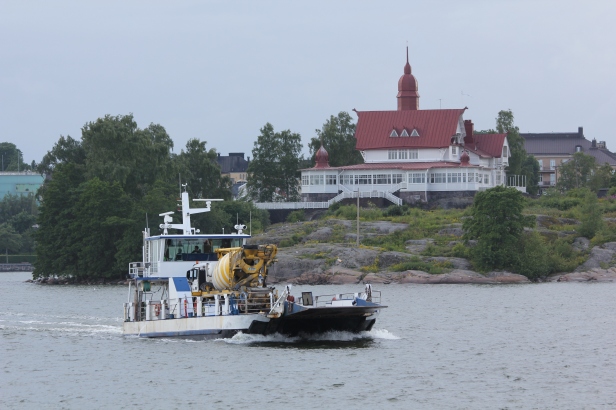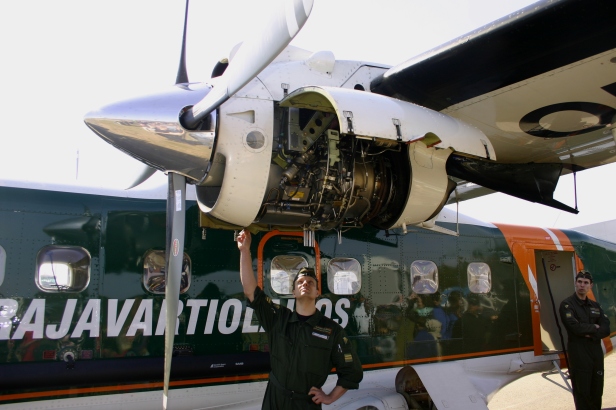The day started with what sounded like a rare but not unique message on Twitter by the Finnish National Bureau of Investigation, the KRP:
The current search by the KRP in the premises of a company located in the Turku Archipelago may attract attention amongst boaters and holidaymakers.
However, the archipelago has seen some interesting developments during the last few years, and the innocent sounding tweet quickly caught the attention of Finnish security wonks. The developments of the day would soon show that the knee-jerk reaction was warranted.
But let’s start from the beginning: Airiston Helmi Oy was founded in 2007 as a non-public stock company for trading in real estate, and a number of the key persons behind the company were Russian nationals. The company has had just a handful of employees, and has consistently been showing figures in the red (as far as I know, it has never managed a single positive year). What has set the company aside from other failing attempts is however that a number of the real estate deals have taken place at strategic locations in the archipelago outside of Turku in southwestern Finland. The main location is Ybbersnäs in Pargas on the Finnish mainland, with another key location being the island of Säckilot.
Location of Säckilot
The sea lane to Turku and Naantali passes just four kilometers south of the island, with a direct line of sight in the south-east. The ports of Turku and Naantali are of vital importance to Finland in peacetime, but would be of even greater importance in wartime thanks to their location as far away as possible from the Russian border. Naantali also houses one of Finland’s two petroleum refineries, with a daily production capacity of 50,000 barrels.

However, companies and individuals buying houses in the Finnish archipelago for vacation homes are nothing out of the ordinary, and the large archipelago coupled with winding sea lanes means that quite a number of these are situated “strategically close” to the routes. Russian investments in Finnish real estate has also been rather high, owing to a number of reasons including Finland being a popular destination for Russian tourists and the stable markets coupled with rule of law making Finnish real estate an attractive investment opportunity for what used to be described as the emerging Russian middle class. The level of investment has gone down with the oil price, but numerous objects are found all over the country. 2016 an official report noted that a large number of Russian-owned real estate were situated in strategic locations and/or had other suspicious indicators connected to them. These included not only the real estate in the archipelago, but also locations close to airports and key mobilisation routes. The term “Hybrid War” was mentioned.

However, for Airiston Helmi things had turned even stranger when they in 2010 through the Finnish company Rederi Ab Fakir (part of the Alfons Håkans Group, a major player in Finnish towage and general shipping) bought two surplus Finnish naval vessels, the workboat Kala 4 and the launch Hakuni. When the Finnish Navy sells older vessels, they demand that the buyer repaint the vessel and change the name to avoid people mistaking them for active duty vessels. This is even a requirement when the vessels are operated by the naval reserve, but in this case Airiston Helmi was in a hurry and Rederi Ab Fakir left the vessels unpainted. The name was also kept, as Airiston Helmi “preferred it” over Rederi Ab Fakir’s suggested Kronos. Notable here is that in this case Airiston Helmi did nothing illegal, as the contract with the Navy only bound Rederi Ab Fakir to change the colour and name (it wouldn’t be the last time the Alfons Håkans Group and the Navy had a bit of a quarrel). Kala has however been modified and stripped of paint since, as is visible in photographs from today’s raid.
But things didn’t stop there. Airiston Helmi soon got into trouble with the local authorities, as the single-family homes they were building in Ybbersnäs and another location in Pargas both featured eight bedrooms each with their own bathroom, in what looked suspiciously much like a small hotel layout. The fact that one of the houses was actually marketed as one further raised eyebrows, and the company had to give official explanations to the city. The helicopter traffic between Ybbersnäs and other locations, mainly Latvia and Helsinki airport, in turn caused the neighbors to complain, but the complaints were dismissed. In addition questions have been raised regarding the exemptions that the company has received for buildings and dredging (though it should be noted that Finnish building exemption policies are notoriously chancy), as well as if they actually have permission to do some of the works that have been performed. And where does the money come from, considering that the company can’t show anything close to a profit?
Cue today’s dawn raid, executed by over 100 persons from the KRP, local police, Tax Administration, Border Guard, and Finnish Defence Forces. Simultaneously a numbered of locations were searched, and a no-fly zone was created over a sizeable area including both Säckilot and Ybbersnäs. No-one is saying much.
Searches are a normal part when investigating financial crimes. Assistance from other authorities has been required due to the geographical locations and the number of places where the search is conducted. Everything has gone smoothly and according to the plans. We have seized such material as is usually seized in searches investigating financial crime.
KRP doesn’t even mention the Finnish Defence Forces in the press release quoted above, but the Finnish Defence Forces confirm that they have “certain skill sets” which they are assisting with. The crimes investigated are money laundering valued at “millions of Euros” and serious tax fraud. The Finnish Defence Forces spokesperson denies that they have any interests in Airiston Helmi, but an anonymous military source contradicted the statement when asked by Helsingin Sanomat. According to the source, both FDF and SUPO (the Finnish Security Intelligence Service) have been keeping an eye on the company for years.
Again, operations of this scope are rare, but entirely plausible.
The Border Guard regularly cooperate with the Police, both sort under the Ministry of Interior in peacetime, and it is not far-fetched that the former would assist with boats and helicopters if there is an operation with several targets in the archipelago. The Finnish Defence Forces also have tight cooperation with the Police, often providing vehicles and special equipment when the need arises.
But it is hard to come up with a suitable need for FDF know-how or equipment in a white-collar raid. And what about the (unconfirmed) reports of the Border Guard having one of their two maritime reconnaissance aircrafts patrol the area of operations? And why is the no-fly zone in effect until Monday?

Edit 230918 1100 GMT+2: It turns out that OH-MVO did visit the location before landing in Helsinki in the early afternoon.
Happy enthusiasts have already decided that Airiston Helmi is a GRU-run operation, complete with vessels for false-flag operations and barracks for spetsnaz units to stay in after infiltrating the country prior to war. It is a possibility, but I am unconvinced.
It is clear that GRU is far from the omnipotent force some authors would like them to be, if nothing else then Salisbury is the final proof. As such the hap-hazard nature of Airiston Helmi isn’t proof of them not being involved. However, it should also be remembered that money laundering is in itself a lucrative business, and there are a numerous reasons for people to want somewhere to stay for a night or two without having to sign a hotel ledger. And if you run a lucrative but highly illegal business, you might want to have some firearms handy in case the competition suddenly comes knocking. This would explain why the KRP chose to ensure that they have the necessary tools to subdue any resistance, including heavier protection and personal firearms (and FDF backup). On the other hand, the Russian cleptocracy makes the dividing lines between crooks, spies, and businessmen somewhat blurred, and even if Airiston Helmi would prove to be a non-political criminal enterprise (it should be noted that no-one is convicted of anything as of yet), it isn’t beyond the realms of imagination for the GRU to call in a favour every now and then (the smuggling case which lead to the abduction of Eston Kohver by the FSB comes to mind).
In any case, don’t expect any clear-cut answers from the authorities within the next few days. And if anyone says they know for certain what’s going on, chances are they are as honest as Airiston Helmi’s bookkeeping.


Comments are closed.